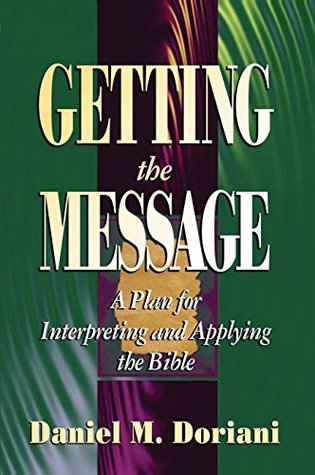Kindle Notes & Highlights
It (2) gains access to historical context through background study of the language, history, customs, and philosophy of the author and his audience.
(3) To exaggerate slightly, historical context allows readers to overcome the feeling that the text belongs to another time or culture and allows them to enter the world of the original speakers, writers, and readers.
your first step is to read your entire book to gain a view of the whole.
You can answer many of these questions yourself by reading your book carefully, noting the author’s statements of purpose.
Literary and historical contexts overlap, influencing and informing each other. But after the initial survey of a book, the literary and historical contexts part ways.
Principle 1: Interpret single verses in light of their immediate context.
Principle 2: Interpret paragraphs and episodes in light of the paragraphs or events around them.
Principle 3: Try to determine why your text belongs precisely where it is, and nowhere else.
Principle 4: Look for thematic statements that introduce or interpret an entire section.
Principle 5: Look for repeated words or phrases.
Repetition frequently indicates the theme for a section.
The books of Kings, always evaluating the faithfulness of Israel, compare southern kings to righteous “David, their father,” and northern kings to wicked “Jeroboam, son of Nebat.”
A section may also have its own refrain.
Individual verses may also be linked by a repeated word or phrase.
Principle 6: Locate your text in the purpose of its section and the whole book.
One major goal of Bible study is to discern the goals of the authors and determine the needs of the first readers.
Literary context Historical context • Studies the written text • Studies the people and culture receiving a text • Can ignore identity of author and audience • Stresses identity of author and audience • Can study words in themselves • Stresses author’s intent as he uses words • Considers what any competent reader hears • Considers what the original audience heard • Is accessible to any attentive reader • Is accessible to readers who know background • Rewards intensive study of one text • Rewards cumulative study of many texts
When we study historical contexts, we try to capture the big picture, the entire scene in and around a book.
A study of the historical context has three goals: (1) to retrieve, as best we can, the world of the Bible, (2) to discover the circumstances involved in the writing and the reading of particular books, and (3) to investigate the individuals and groups who play roles in the biblical drama.
Principle 1: The more we know about the world of the Bible, the better we understand the Bible itself.
1. Increase your sensitivity to background information.
2. If you are engaged in a serious study of one biblical book, read through it for hints about the daily world of the author and his readers. Jot down your observations and your questions.
3. Develop and use a Christian library. Consult your Bible dictionary or encyclopedia whenever you have the time to pursue a question.
4. The basic Christian library will tell you most of what you want to know, but a vast, complicated literature winks at and whistles to the curious.
many books of the Bible were written when the Holy Spirit used local crises to prompt his servants to write.
It is just as important, although harder, to locate a book’s first readers and consider how it struck them.
it often helps to track the audience’s relationship with the author. Were they old friends (Hebrews), strangers (Paul and the Romans), antagonists (Isaiah, Jeremiah, or Ezekiel and most Israelites)?
1. Accepting. Authors may expect their readers to accept their message without reservation.
In this category we think of Genesis, Judges, Ruth, Psalms, Proverbs, Matthew, Philippians, 1 and 2 Timothy, Titus, 1 Peter, and 1 John.
2. Ambivalent. The Lord himself describes the second type of audience when he tells Ezekiel, “With their mouths they express devotion, but t...
This highlight has been truncated due to consecutive passage length restrictions.
3. Rejecting. In a few books, such as Jeremiah, Amos, Galatians, and 2 Corinthians, prophets and apostles had to face bona fide opposition.
Principle 2: To evaluate the relationship between a writer and his readers, look for pointed questions and objections, sharp rebukes, and terms of endearment.
Principle 3: In historical books we need to understand the cultures of the people who acted out the dramas of the Bible.
Who? Who are the people and groups mentioned in the book? Do they have a history?
When? When did the events described take place, and when was the book written? What had God and his people done recently? Where did the event stand in the history of redemption? How much did the people know about the way of salvation?
Where? In what land and culture did the events occur?
What? and Why? What did the author want to teach to his people through the story he relates? And why did the characters act as they did? What did they know or not know? What is their history?
• Good works salvation. • Not even the Judaizers believed that works alone merit salvation. • Faith + good works salvation. • The Judaizers said faith + legal works bring salvation. • Faith salvation + good works. • Both James and Paul say that works must follow salvation. • Faith salvation (no works). • No apostle taught that good works have no place.
The gathering of historical background information is a lifelong task. The difficulty of pursuing background studies is that it takes far more time than an ordinary person can devote to it for one lesson.
every time you study the background for a topic and teach it to others, you will keep part of that study for a lifetime.


